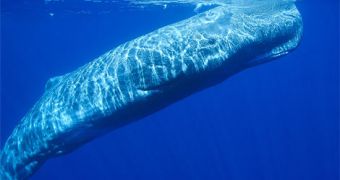Have you ever wondered how whales sleep? Actually, just like us, but in short naps. This was showed by a new research led by Dr. Patrick Miller of the University of St. Andrews, who captured on video drifting behavior in sperm whales. Sperm whales in the wild turn off completely conscious activity for short 'cat naps'. The research also shows that sperm whales may sleep less than other mammal species.
The drifting behavior ('drift-dives') was found using tags attached with suction cups to 59 whales worldwide, thus this seems to be valid for all sperm whales.
"Many mammals show species-typical sleeping behavior, such as dogs circling before lying down, lending support to the idea that sperm whales sleep during these drift dives. One exciting aspect of this finding is that it suggests that the largest toothed whale actually might sleep in a fashion that we recognize as similar to sleep in terrestrial mammals. The sperm whale behavior we describe seems to allow normal-looking quiescent sleep, possibly including REM sleep which has never been clearly observed in any cetacean," said Miller.
A similar video was captured by a St. Andrews team led by Dr. Luke Rendell off the coast of Northern Chile: 6 still sperm whales floating vertically, with their heads close to the sea surface. 3 did not react to the presence of the boat, until one was accidentally touched.
"Reduced responsiveness that reverses with sufficient stimulation to cause waking is another important criteria that allows us to consider this to be a sleeping behavior," explained Miller.
Moreover, the video displays the whales asleep with both eyes shut. Researches made on captive dolphins (sperm whales are rather related to dolphins than baleen whales) have showed that cetaceans sleep with just one half of the brain at a time.
"Our study presents the first evidence that whales in the wild may sleep with both sides of the brain (bihemispheric). This is supported by the fact that the whales we approached did not react to the boat even though it was visible to both eyes. From what we have found, the amount of time sperm whale seem to have for sleep is very little, so it would make more sense for them to sleep both sides at a time. One of the theories for why cetaceans in captivity sleep with one side of their brain at a time (uni-hemispheric) is so they can keep looking out for their pod-mates or for danger with one open eye. Instead, the whales that we approached seemed to be non-responsive with either eye - which is unusual because it is very rare to ever get that close to sperm whales at sea," said Miller.
The 562 hours of investigation showed that sperm whales sleep only 7.1% of the time, mainly between 6 pm and midnight (humans, for example, sleep 28-33% of the time).
"The challenge for the future is to develop new technologies that might allow us to measure the brain waves of these animals during sleep at sea," said Miller.

 14 DAY TRIAL //
14 DAY TRIAL //